The Bio-Desulfurization of Cassiterite–Polymetallic Sulfide Ores Enhanced by a Consortium of Moderately Thermophilic Bacteria
Abstract
1. Introduction
2. Materials and Methods
2.1. Minerals
2.2. Bacterial Strains and Cultivation Conditions
2.3. Bioleaching Experiments
2.4. EPS Extraction and Measurement
2.5. Community Structure Analysis of the Mixed Culture
2.5.1. DNA Extraction
2.5.2. Primers and PCR Amplification for High-Throughput Sequencing and Calculation of Cell Number of Three Strains
3. Results
3.1. The Bio-Desulfurization of Tin Ore by the Moderately Thermophilic Bacteria
3.2. Changes in pH and Oxidation–Reduction Potential During Bio-Desulfurization of Tin-Rich Ore
3.3. SEM and XRD Analysis of Residues After Desulfurization of Tin Ore
3.4. Community Success and EPS Changes in Mixed Culture During Bio-Desulfurization of Tin Ore
4. Discussion
4.1. Mixed Culture of the Moderately Thermophilic Bacteria Enhanced the Bio-Desulfuriztion of Tin Ore
4.2. Qualitative and Quantitative Analysis of the Desulfurization System
4.3. Mechanism of Mixed Culture Enhancing Bio-Desulfurization of Tin-Rich Ore
5. Conclusions
Author Contributions
Funding
Data Availability Statement
Conflicts of Interest
Abbreviations
| XRD | X-ray Diffraction |
| XRF | X-ray Fluorescence |
| ICP | Inductively Coupled Plasma |
| ORP | Oxide Redox Potential |
| EPS | Extracellular Polymeric Substance |
| e-PN | Extracellular Proteins |
References
- Li, H.; Qin, W.; Li, J.; Tian, Z.; Jiao, F.; Yang, C. Tracing the global tin flow network: Highly concentrated production and consumption. Resour. Conserv. Recycl. 2021, 169, 105495. [Google Scholar] [CrossRef]
- Su, Z.; Zhang, Y.; Liu, B. Extraction and Separation of Tin from Tin-Bearing Secondary Resources: A Review. JOM J. Miner. Met. Mater. Soc. 2017, 69, 2364–2372. [Google Scholar] [CrossRef]
- Yassine, A.-K.; Mostafa, B.; Isabelle, D. Environmental desulfurization of mine wastes using various mineral processing techniques: Recent advances and opportunities. Miner. Eng. 2021, 174, 107225. [Google Scholar]
- Matveeva, T.N.; Chanturiya, V.A.; Getman, V.V.; Gromova, N.K.; Minaev, V.A. The Effect of Complexing Reagents on Flotation of Sulfide Minerals and Cassiterite from Tin-Sulfide Tailings. Miner. Process. Extr. Metall. Rev. 2020, 43, 346–359. [Google Scholar] [CrossRef]
- Bunin, I.Z.; Khabarova, I.A.; Ryazantseva, M.V. The Effect of Low-Temperature Atmospheric Discharge Plasma on the Physical–Chemical and Technological Properties of Iron Sulfide Minerals; Springer Nature: Cham, Switzerland, 2025. [Google Scholar]
- Koyunoğlu, C.; Karaca, H. Microbial desulphurisation of coal: A review. Int. J. Sustain. Energy 2023, 42, 1–24. [Google Scholar] [CrossRef]
- Khan, J.; Ali, M.I.; Khan Achakzai, J.; Jamal, A.; Ahmed, I.; Manan Kakar, A.; Uddin, S. Sequential Chemical and Biological Desulphurization of High Sulfur Containing Pakistani Coal. Geomicrobiol. J. 2024, 41, 959–965. [Google Scholar] [CrossRef]
- Angadi, S.I.; Sreenivas, T.; Jeon, H.S.; Baek, S.H.; Mishra, B.K. A review of cassiterite beneficiation fundamentals and plant practices. Miner. Eng. 2015, 70, 178–200. [Google Scholar] [CrossRef]
- Levie, M.; Chitalu, C.; Jeanne, P.M.; Govinda, P.K.; Subramanian, S.; Hyunjung, K.; Lev, F. Experimental, benchmarks and theoretical investigations into the complexation of chalcopyrite and silica with guar gum and beneficiation of a siliceous copper ore using polyethylene oxide as a silica depressant. Miner. Eng. 2024, 216, 108874. [Google Scholar]
- Vera, M.; Schippers, A.; Sand, W. Progress in bioleaching: Fundamentals and mechanisms of microbial metal sulfide oxidation–part A. Appl. Microbiol. Biotechnol. 2022, 106, 6933–6952. [Google Scholar] [CrossRef]
- Chenbing, A.; Yuting, L.; Bo, M.; Chen, M.; Zeng, W.; Guanzhou, Q. Identification and Analysis of a Novel Gene Cluster Involves in Fe(2+) Oxidation in Acidithiobacillus ferrooxidans ATCC 23270, a Typical Biomining Acidophile. Curr. Microbiol. 2018, 75, 818–826. [Google Scholar]
- Chenbing, A.; Zhang, Y.; Hongsheng, C.; Tianyuan, G.; Junjun, W.; Liyuan, C. Increased chalcopyrite bioleaching capabilities of extremely thermoacidophilic Metallosphaera sedula inocula by mixotrophic propagation. J. Ind. Microbiol. Biotechnol. 2019, 46, 1113–1127. [Google Scholar]
- Caporaso, J.G.; Lauber, C.L.; Walters, W.A.; Berg-Lyons, D.; Huntley, J.; Fierer, N. Ultra-high-throughput microbial community analysis on the Illumina HiSeq and MiSeq platforms. ISME J. 2012, 6, 1621–1624. [Google Scholar] [CrossRef] [PubMed]
- Pina, P.S.; Oliveira, V.A.; Flávio, L.S.; Cruz Leeo, V.A. Kinetics of ferrous iron oxidation by Sulfobacillus thermosulfidooxidans. Biochem. Eng. J. 2010, 51, 194–197. [Google Scholar] [CrossRef]
- Leahy, M.J.; Davidson, M.R.; Schwarz, M.P. A model for heap bioleaching of chalcocite with heat balance: Mesophiles and moderate thermophiles. Hydrometallurgy 2007, 85, 24–41. [Google Scholar] [CrossRef]
- Liu, C.; Li, X.T.; Han, Y.; Li, W.; Gao, Y.; Jiang, C.; Yu, L.; Zheng, Y. Enhanced pyrite bioleaching through the synergistic interactions between Sulfobacillus thermosulfidooxidans and Alicyclobacillus ferrooxydans. Environ. Technol. Innov. 2025, 37, 104005. [Google Scholar] [CrossRef]
- Vardanyan, A.; Khachatryan, A.; Castro, L.; Willscher, S.; Gaydardzhiev, S.; Zhang, R.; Vardanyan, N. Bioleaching of Sulfide Minerals by Leptospirillum ferriphilum CC from Polymetallic Mine (Armenia). Minerals 2023, 13, 243. [Google Scholar] [CrossRef]
- Rito, B.; Almeida, D.; Coimbra, C.; Diogo, V.; Romeu, F.; Rita, B.; Harald, W.; Paula, V.M. Post-measurement compressed calibration for ICP-MS-based metal quantification in mine residues bioleaching. Sci. Rep. 2022, 12, 16007. [Google Scholar] [CrossRef]
- Mingwei, W.; Christel, V.; Bente, S.; Huang, Y.; Xueling, W.; Li, S.; Jiaokun, L.; Yuandong, L.; Runlan, Y.; Wolfgang, R.S.; et al. Extracellular proteins enhance Cupriavidus pauculus nickel tolerance and cell aggregate formation. Bioresour. Technol. 2024, 393, 130133. [Google Scholar]
- Liu, A.; Yu, R.; Qiu, G.; Zeng, W. Insights into the EPS production and distribution of planktonic and attached Sulfobacillus thermosulfidooxidans cells during bioleaching. Miner. Eng. 2014, 205, 108494. [Google Scholar] [CrossRef]
- Ai, C.; Yan, Z.; Hou, C.; Zeng, W. Metagenomic Insights into the Effects of Seasonal Temperature Variation on the Activities of Activated Sludge. Microorganisms 2019, 7, 713. [Google Scholar] [CrossRef]
- Kumar, A.; Saini, H.S.; Engr, S.; Sani, R.K.; Kumar, S. Bioleaching of metals from waste printed circuit boards using bacterial isolates native to abandoned gold mine. Biometals 2021, 34, 1043–1058. [Google Scholar] [CrossRef]
- Rouchalová, D.; Rouchalová, K.; Čablík, V. Bioleaching of mine tailings by mesophilic: Acidithiobacillus spp., Leptospirillum ferrooxidans, and Thermophilic: Sulfobacillus thermosulfidooxidans cultures with the addition of Ag+ additive. Minerals 2024, 14, 255. [Google Scholar] [CrossRef]
- Wang, Y.J.; Li, L.L.; Zhao, S.; Chen, Y.; Yu, A.F. Bioleaching of metals from spent fluid catalytic cracking catalyst using adapted Acidithiobacillus caldus. Environ. Sci. Pollut. Res. 2023, 30, 125689–125701. [Google Scholar] [CrossRef] [PubMed]
- Wu, X.L.; Liao, W.Q.; Peng, T.J.; Shen, L.; Qiu, G.; Zeng, W. Biodissolution of pyrite and bornite by moderate thermophiles. J. Cent. South Univ. 2022, 29, 3630–3644. [Google Scholar] [CrossRef]
- Chen, L.; Liu, X.; Gao, C.; Guan, Y.; Lin, J.; Liu, X.; Pang, X. The essential role of OmpR in Acidithiobacillus caldus adapting to the high osmolarity and its regulation on the tetrathionate-metabolic pathway. Microorganisms 2022, 11, 35. [Google Scholar] [CrossRef] [PubMed]
- Chen, G.; Shi, H.; Ding, H.; Zhang, X.; Gu, T.; Zhu, M.; Tan, W. Multi-scale analysis of nickel ion tolerance mechanism for thermophilic Sulfobacillus thermosulfidooxidans in bioleaching. J. Hazard. Mater. 2023, 443, 130245. [Google Scholar] [CrossRef] [PubMed]
- Vladimir, A.; Daniel, L.; José, J.G.; Fanny, B.; Ismael, M. Analysis of the Oxidation-Reduction Potential and Bacterial Population of Acidithiobacillus ferrooxidans during the Bioleaching Study of Sulfide Ores; IntechOpen: London, UK, 2023. [Google Scholar]
- Hee, S.; Dae-Weon, K.; Byung, M.; Sang, W. A Study on the Leaching and Recovery of Lithium by Reaction between Ferric Chloride Etching Solution and Waste Lithium Iron Phosphate Cathode Powder. Resour. Recycl. 2023, 32, 9–17. [Google Scholar]
- Liu, R.; Zhou, H. Growth in ever-increasing acidity condition enhanced the adaptation and bioleaching ability of Leptospirillum ferriphilum. Int. Microbiol. 2022, 25, 541–550. [Google Scholar] [CrossRef]
- René, H.L.; Jorge, V.A.; Guadalupe, R.; Marcelo, G.; Luis, L. Experimental and Theoretical Analysis Accounting for Differences of Pyrite and Chalcopyrite Oxidative Behaviors for Prospective Environmental and Bioleaching Applications. J. Phys. Chem. C 2015, 119, 18364–18379. [Google Scholar]
- Falco, L.; Pogliani, C.; Curutchet, G.; Donati, E. A comparison of bioleaching of covellite using pure cultures of Acidithiobacillus ferrooxidans and Acidithiobacillus thiooxidans or a mixed culture of Leptospirillum ferrooxidans and Acidithiobacillus thiooxidans. Hydrometallurgy 2003, 71, 31–36. [Google Scholar] [CrossRef]
- Panyushkina, A.E.; Tsaplina, I.A.; Kondrat’eva, T.F.; Bely, A.V.; Bulaev, A.G. Physiological and Morphological Characteristics of Acidophilic Bacteria Leptospirillum ferriphilum and Acidithiobacillus thiooxidans, Members of a Chemolithotrophic Microbial Consortium. Microbiology 2018, 87, 326–338. [Google Scholar] [CrossRef]
- Xia, L.X.; Lu TA, N.G.; Xia, J.L.; Chu YI, N.; Cai, L.Y.; Zhao, X.J.; Nie, Z.Y.; Liu, J.S.; Qiu, G.Z. Relationships among bioleaching performance, additional elemental sulfur, microbial population dynamics and its energy metabolism in bioleaching of chalcopyrite. Trans. Nonferr. Met. Soc. China 2012, 22, 192–198. [Google Scholar] [CrossRef]
- Oladipo, B.; Ojumu, T.V. Influence of solution pH on the properties of biogenic jarosite produced from ferrous ion bio-oxidation in a bioreactor. Hydrometallurgy 2023, 221, 106144. [Google Scholar] [CrossRef]
- Bellenberg, S.; Salas, B.; Ganji, S.; Jorquera-Román, C.; Valenzuela, M.L.; Buetti-Dinh, A.; Unelius, C.R.; Dopson, M.; Vera, M. Diffusible signal factor signaling controls bioleaching activity and niche protection in the acidophilic, mineral-oxidizing leptospirilli. Sci. Rep. 2021, 11, 16275. [Google Scholar] [CrossRef]
- Zeng, W.; Liu, Z.; Liao, W.; Cheng, J.; Wu, X.; Qiu, G.; Shen, L. Distribution and content changes of extracellular polymeric substance and iron ions on the pyrite surface during bioleaching. J. Cent. South Univ. 2023, 30, 95–107. [Google Scholar] [CrossRef]
- Castro, L.; Zhang, R.; Muñoz, J.A.; González, F.; Blázquez, M.L.; Sand, W.; Ballester, A. Characterization of exopolymeric substances (EPS) produced by Aeromonas hydrophila under reducing conditions. Biofouling 2014, 30, 501–511. [Google Scholar] [CrossRef] [PubMed]
- Gao, X.-Y.; Liu, X.-J.; Fu, C.-A.; Gu, X.-F.; Lin, J.-Q.; Liu, X.-M.; Pang, X.; Lin, J.-Q.; Chen, L.-X. Novel Strategy for Improvement of the Bioleaching Efficiency of Acidithiobacillus ferrooxidans Based on the AfeIR Quorum Sensing System. Minerals 2022, 10, 236–246. [Google Scholar]
- Bellenberg, S.; Huynh, D.; Poetsch, A.; Sand, W.; Vera, M. Proteomics Reveal Enhanced Oxidative Stress Responses and Metabolic Adaptation in Acidithiobacillus ferrooxidans Biofilm Cells on Pyrite. Front. Microbiol. 2019, 10, 592. [Google Scholar] [CrossRef]
- Jia, W.; Bingyang, T.; Yihui, B.; Can, Q.; Yiran, Y.; Tianqi, N.; Baoping, X. Functional exploration of extracellular polymeric substances (EPS) in the bioleaching of obsolete electric vehicle LiNixCoyMn1-x−yO2 Li-ion batteries. J. Hazard. Mater. 2018, 354, 250–257. [Google Scholar]
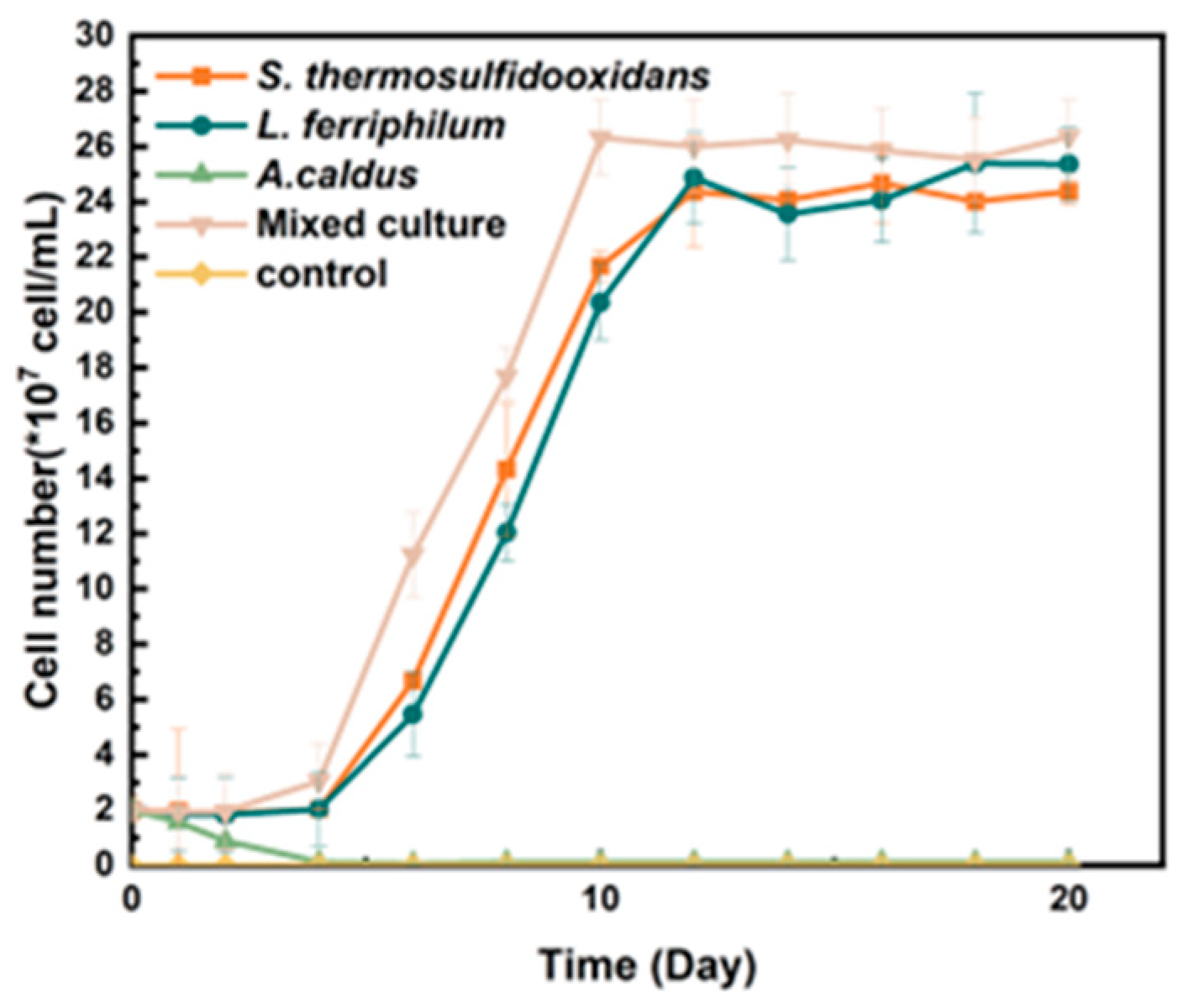
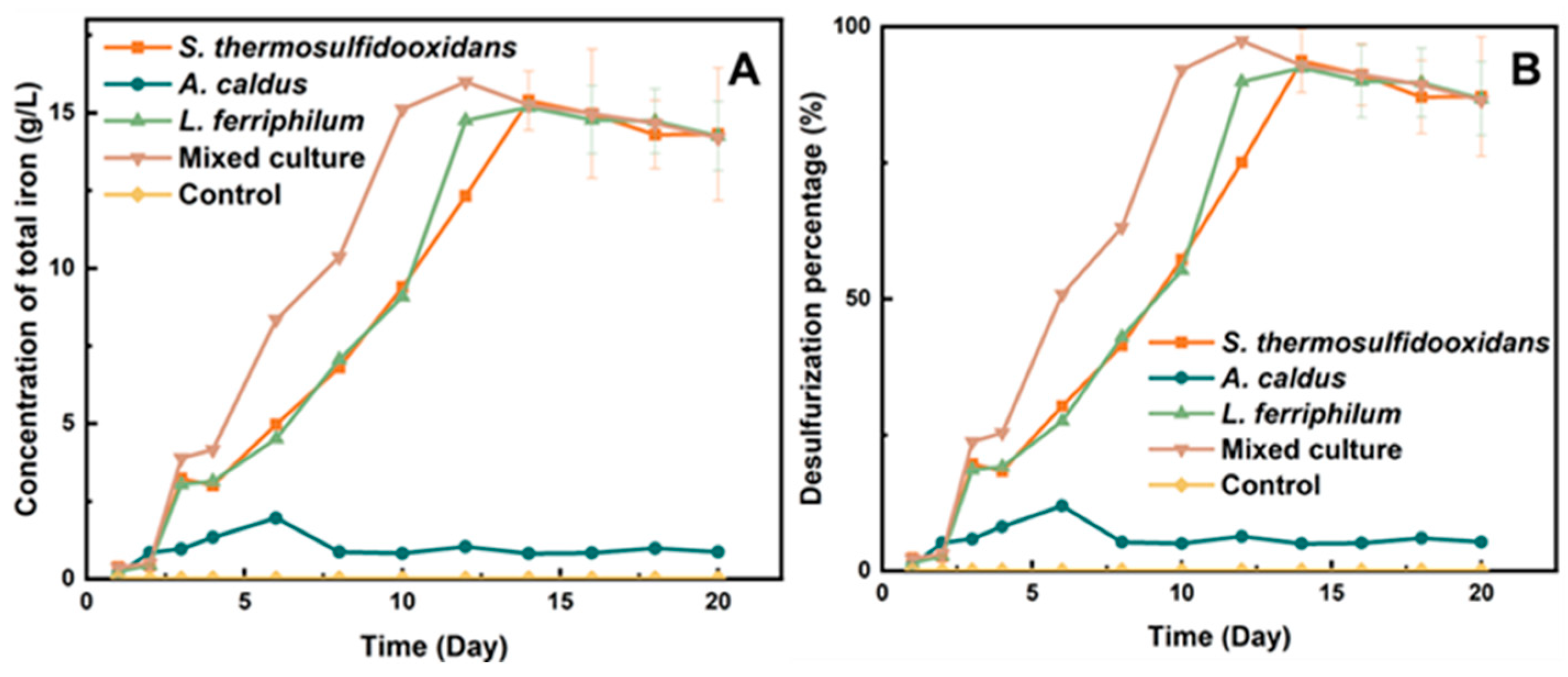
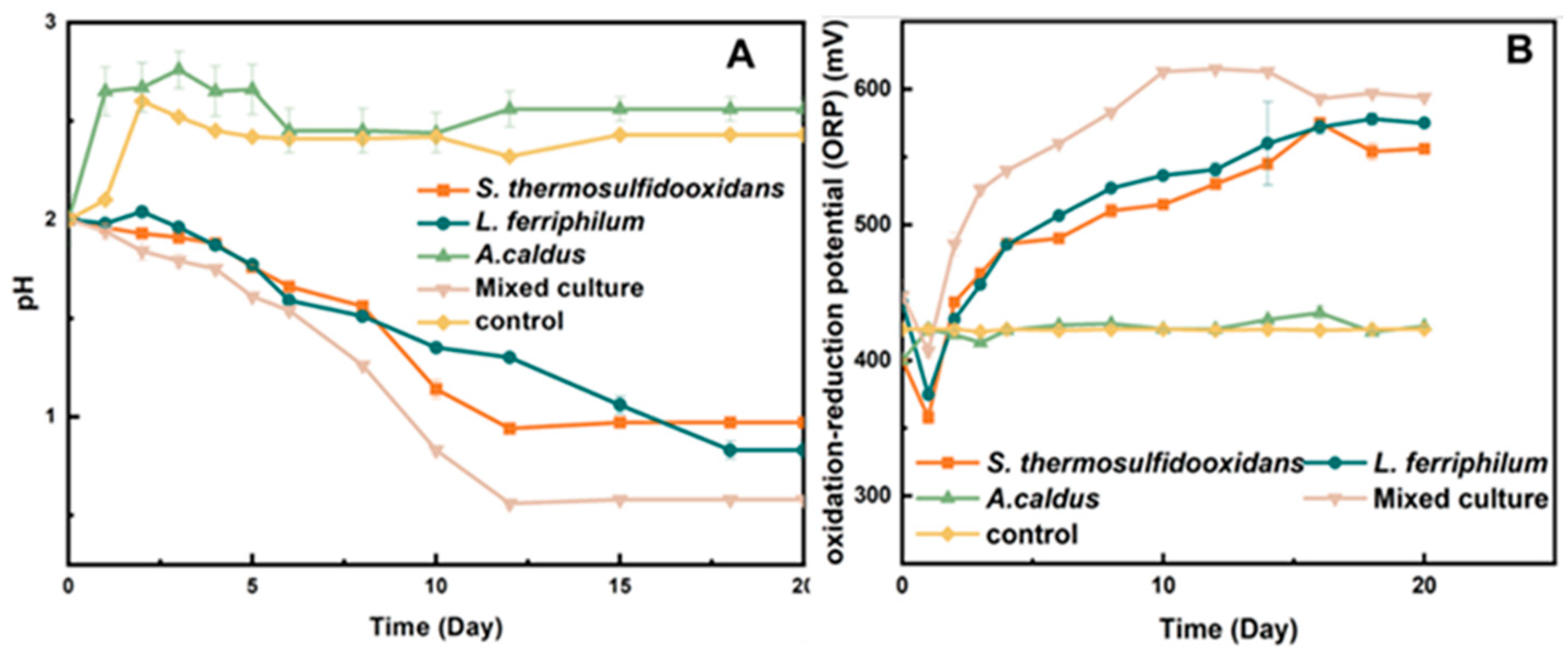
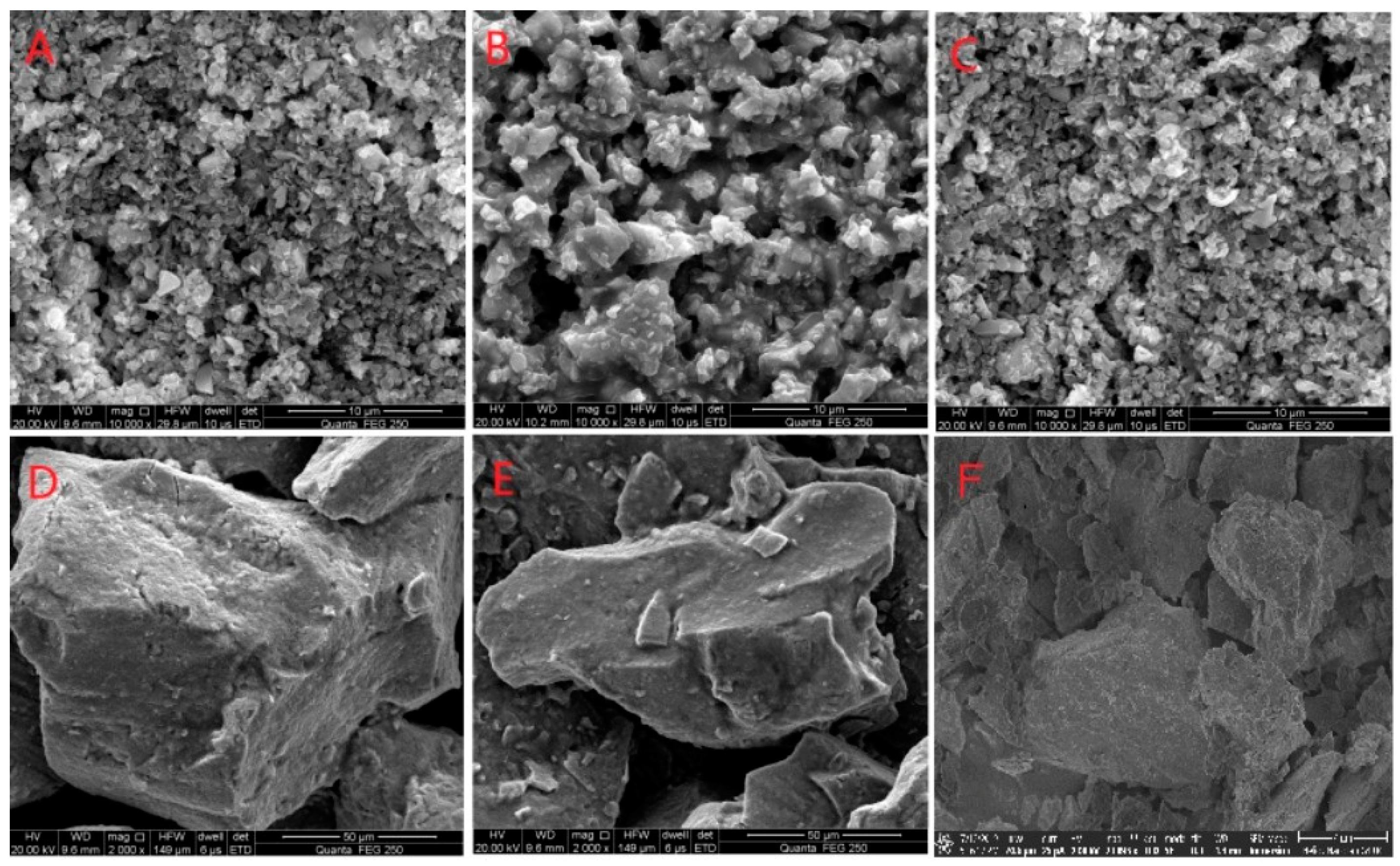
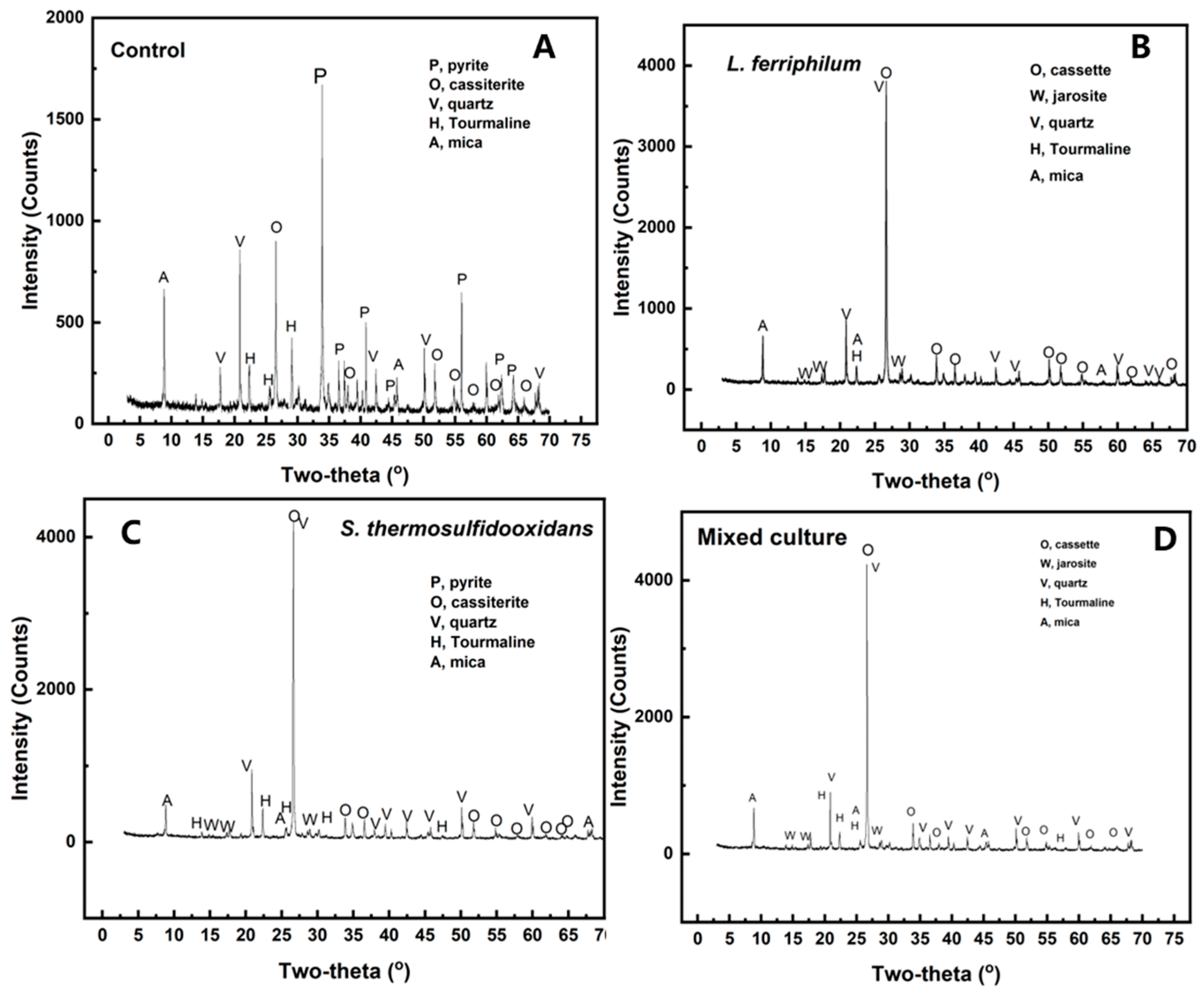

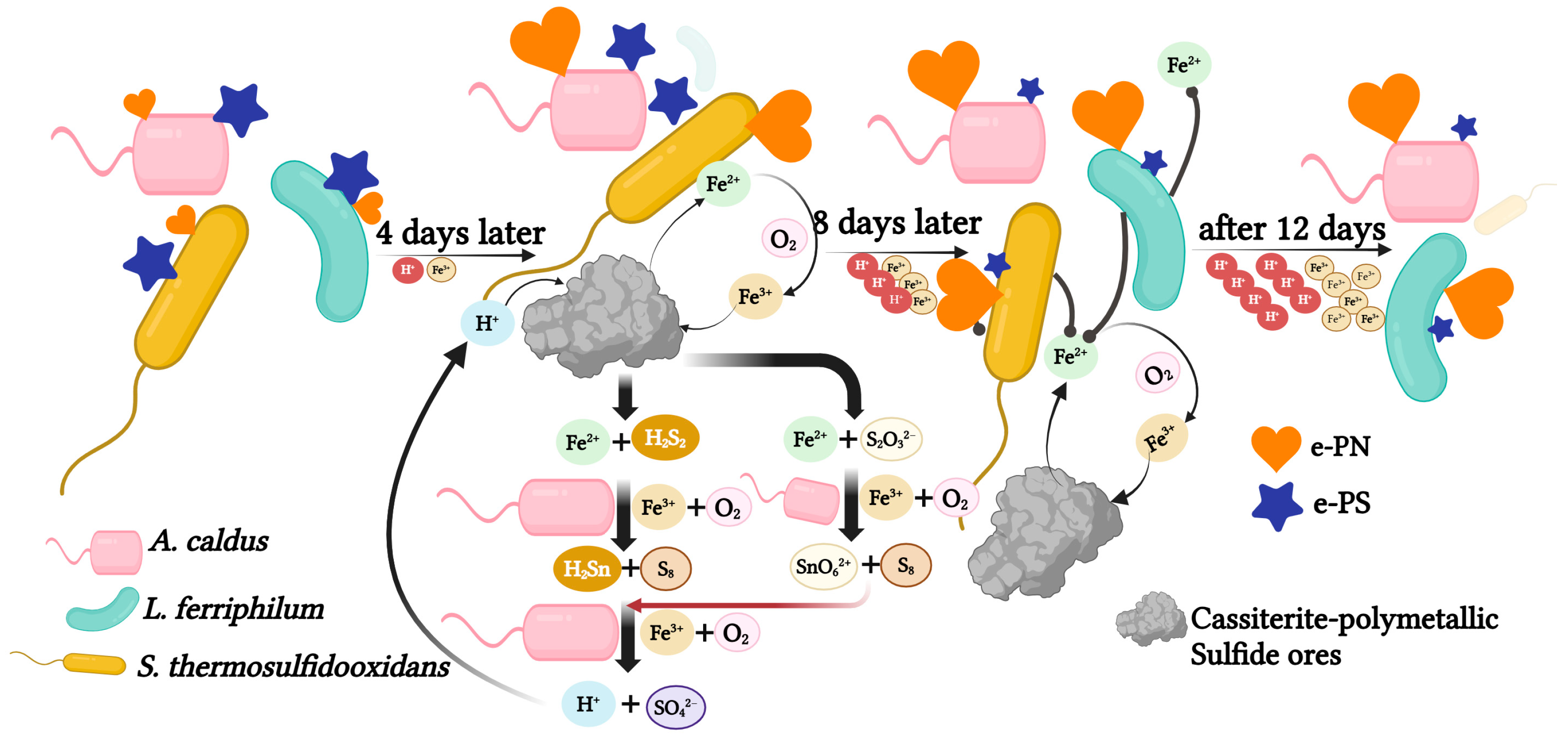
| Phase (Percentage > 0.1%, 1%) | Pyrite | Jarosite | Cassiterite | Quartz | Tourmaline | Mica | Others |
|---|---|---|---|---|---|---|---|
| Mixed culture | 0 | 5.74 | 26.46 | 37.84 | 11.57 | 15.39 | 2.82 |
| L. ferriphilum | 0 | 6.34 | 26.38 | 38.19 | 12.28 | 14.29 | 2.52 |
| S. thermosulfidooxidans | 0 | 5.86 | 26.62 | 33.56 | 12.15 | 18.32 | 3.49 |
| Control | 44.76 | 0 | 21.96 | 18.54 | 8.17 | 8.20 | 13.74 |
| Z | Formula | Concentration % Control | L. ferriphilum | S. thermosulfidooxidans | Mix Culture |
|---|---|---|---|---|---|
| 8 | O | 35.1 | 41.8 | 42 | 41.9 |
| 11 | Na | 0.163 | 0.295 | 0.311 | 0.313 |
| 12 | Mg | 0.633 | 0.907 | 0.929 | 0.956 |
| 13 | Al | 2.26 | 5.642 | 5.626 | 5.591 |
| 14 | Si | 22.71 | 25.82 | 26.42 | 26.9 |
| 15 | P | 0.0036 | 0.0944 | 0.0768 | 0.0724 |
| 16 | S | 17.52 | 2.31 | 2.12 | 1.72 |
| 19 | K | 0.4 | 1.87 | 1.76 | 0.013 |
| 20 | Ca | 1.0902 | 0.0749 | 0.0807 | 1.63 |
| 22 | Ti | 0.1 | 0.351 | 0.345 | 0.0766 |
| 24 | Cr | 0.003 | 0.014 | 0.014 | 0.347 |
| 25 | Mn | 0.003 | 0.004 | 0.004 | 0.014 |
| 26 | Fe | 16.29 | 3.269 | 2.84 | 0.005 |
| 29 | Cu | 0.003 | 0.007 | 0.006 | 2.298 |
| 30 | Zn | 0.004 | 0.003 | 0.003 | 0.007 |
| 31 | Ga | 0.001 | 0.003 | 0.003 | 0.003 |
| 33 | As | 0.012 | 0.011 | 0.01 | 0.003 |
| 37 | Rb | 0.005 | 0.0069 | 0.006 | 0.009 |
| 38 | Sr | 0.001 | 0.001 | 0.0169 | 0.0059 |
| 40 | Zr | 0.0132 | 0.0171 | 0.001 | 0.001 |
| 41 | Nb | 0.002 | 0.001 | 0.021 | 0.0021 |
| 48 | Cd | 0.002 | 0.021 | 3.766 | 0.023 |
| 50 | Sn | 3.66 | 3.785 | 3.766 | 4.781 |
| 74 | W | 0.003 | 0.01 | 0.0275 | - |
| 82 | Pb | 0.016 | 0.0325 | 0.0368 | 0.0283 |
| 83 | Bi | 0.002 | 0.0444 | 0.0321 | 0.0298 |
Disclaimer/Publisher’s Note: The statements, opinions and data contained in all publications are solely those of the individual author(s) and contributor(s) and not of MDPI and/or the editor(s). MDPI and/or the editor(s) disclaim responsibility for any injury to people or property resulting from any ideas, methods, instructions or products referred to in the content. |
© 2025 by the authors. Licensee MDPI, Basel, Switzerland. This article is an open access article distributed under the terms and conditions of the Creative Commons Attribution (CC BY) license (https://creativecommons.org/licenses/by/4.0/).
Share and Cite
Wang, M.; Zeng, W.; Yan, Z.; Shen, L.; Yu, R.; Wu, X.; Li, J.; Qiu, G.; Streit, W.; Liu, Y. The Bio-Desulfurization of Cassiterite–Polymetallic Sulfide Ores Enhanced by a Consortium of Moderately Thermophilic Bacteria. Separations 2025, 12, 61. https://doi.org/10.3390/separations12030061
Wang M, Zeng W, Yan Z, Shen L, Yu R, Wu X, Li J, Qiu G, Streit W, Liu Y. The Bio-Desulfurization of Cassiterite–Polymetallic Sulfide Ores Enhanced by a Consortium of Moderately Thermophilic Bacteria. Separations. 2025; 12(3):61. https://doi.org/10.3390/separations12030061
Chicago/Turabian StyleWang, Mingwei, Weimin Zeng, Zhen Yan, Li Shen, Runlan Yu, Xueling Wu, Jiaokun Li, Guanzhou Qiu, Wolfgang Streit, and Yuandong Liu. 2025. "The Bio-Desulfurization of Cassiterite–Polymetallic Sulfide Ores Enhanced by a Consortium of Moderately Thermophilic Bacteria" Separations 12, no. 3: 61. https://doi.org/10.3390/separations12030061
APA StyleWang, M., Zeng, W., Yan, Z., Shen, L., Yu, R., Wu, X., Li, J., Qiu, G., Streit, W., & Liu, Y. (2025). The Bio-Desulfurization of Cassiterite–Polymetallic Sulfide Ores Enhanced by a Consortium of Moderately Thermophilic Bacteria. Separations, 12(3), 61. https://doi.org/10.3390/separations12030061







